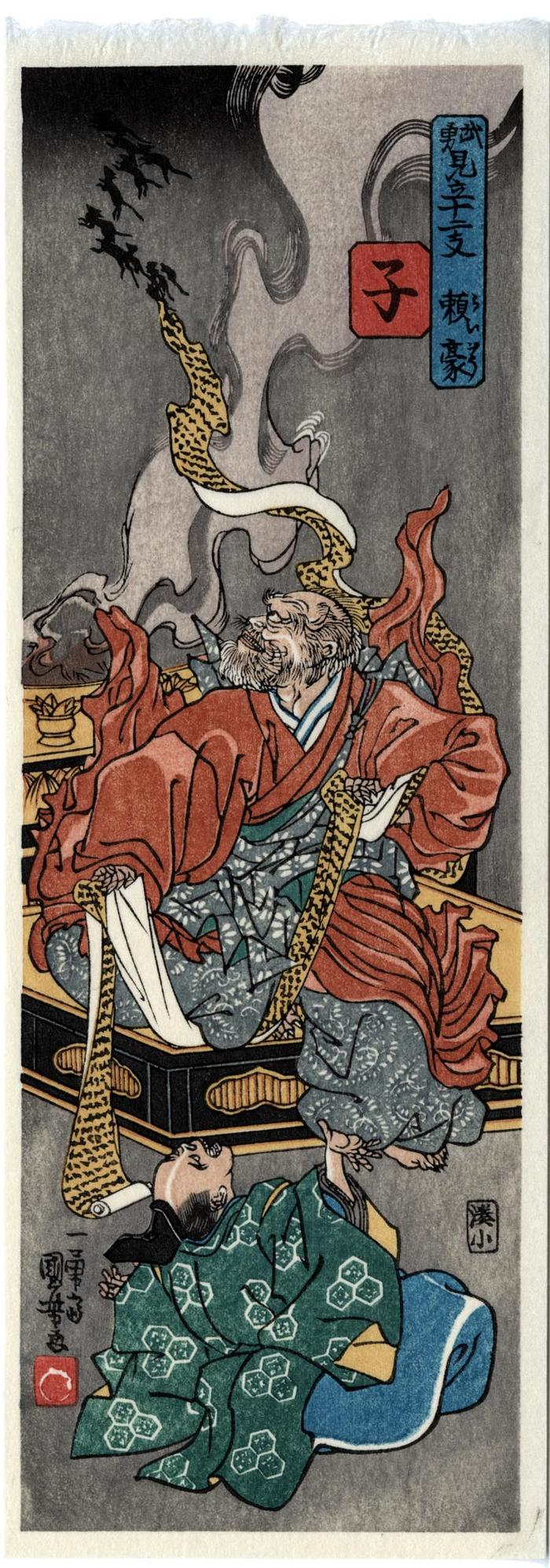Utagawa Kuniyoshi (歌川国芳) (artist 11/15/1797 – 03/05/1861)
From the series Bravery Matched with the Twelve (Zodiac) Signs: (Buyū mitate jūnishi - 武勇見立十二支) Rat (子) and Raigō (頼豪) - a modern edition
ca 2017
4 in x 11.4 in (Overall dimensions) Japanese woodblock print
Signature (copied from the original): Ichiyūsai Kuniyoshi ga
一勇斎国芳画
Artist's seal in red (copied): toshidama
Publisher's seal (copied): Minatoya Kohei
(Marks 332 - seal closest to 25-538)
The National Museum of Asian Art - an original version
Museum of Fine Arts, Boston - the original ca. 1840 print
Chazen Museum of Art
Art Gallery of South Australia The original print by Kuniyoshi was published in ca. 1840. Marks listed seal (25-538), which is the closest to the seal on the first edition of this print, is said to have been used from 1847-62. This is not surprising since none of the 50,000+ prints in the collection of the Museum of Fine Arts in Boston - the largest collection in the Western world - is cited in Marks's Publishers of Japanese Woodblock Prints: A Compendium. Not only does he not list any of the prints or their artists in this volume, but it means that many of the listings on each publisher are incomplete.
"Raigo (1002-1086) a Buddhist priest of the Miidera temple, vents his fury at the emperor's refusal to build an ordination platform for his temple in recognition of Raigo's successful prayers for the birth of the emperor's son. Bitterly disappointed, Raigo vowed to starve himself to death, and to end the young prince's life as well. The story of Raigo became popular during the Edo period, when its theme of opposition to injustice was recounted in popular literature, kabuki, and prints. Raigo-;here associated with the rat, the first animal in the zodiac cycle-holds an unrolled Buddhist sutra that he transforms into rats through his magical powers. In other versions of the story, Raigo transforms himself into a rat or a colony of rats and continuously devours the temple's precious sutras destroying the very scriptures that once inspired him."
Quoted directly from the curatorial files at the National Museum of Asian Art.
****
This example was carved and printed ca 2017 by master carver, Kitamura Shōichi (北村昇一). The fine printing combines graded color in a dynamic, swirling composition of exceptional artistry.
****
Laura Nuffer in her 2014 doctoral dissertation, 'Of Mice and Maidens: Ideologies of Interspecies Romance in Late Medieval and Early Modern Japan', from the University of Pennsylvania wrote about Raigō on pages 65-66: "These darker portrayals of mice were not without medieval precedents; for instance, some variants of Heike monogatari include an episode in which the vengeful ghost of the priest Raigō manifests itself as a giant mouse." In footnote 135 on page 66 Nuffer adds: "This episode occurs in the Engyōbon Heike and Genpei jōsuiki, and also found its way into the expansively eclectic Taiheiki. By contrast, in the Kakuichi Heike, Raigō’s vengeful ghost remains an incorporeal menace. The Raigō nezumi – otherwise known as the tessō, or iron mouse – joined the kyūso as a stock figure in the Edo menagerie of the monstrous, and proved sufficiently horrifying to serve as the evil mastermind in Tanizawa Bakin’s Raigō ajari kaisoden, or “The Tale of High Priest Raigō, the Phantom Mouse,” an eight-volume gōkan published in 1808."
Nuffer wrote on pages 66-67 about the meaning of the word 'nezumi': "The host of complications surrounding the seemingly straightforward title Nezumi no sōshi should by now be apparent. Further compounding these complications is the word nezumi itself, which likewise defies ready definition. Although I have thus far been glossing nezumi as “mouse,” this hardly captures the full range of meanings inherent in the word. In both modern and classical Japanese, nezumi refers equally to rats and mice; used in its broadest sense, the word might also be applied to other small rodents such as voles and dormice, as well as soricomorphs such as moles and shrews. Nezumi thus encompasses a semantic domain that does not map comfortably onto the informal system of classification embedded in the English language, much less formal Linnaean taxonomy." On page 69 Nuffer adds: "The character dictionary Wamyō ruijushō (“A Lexicon of Japanese Names”), compiled in 934 by Minamoto no Shitagō, defines nezumi as “small beasts that live in holes, of which there are many different sorts.”"
Because of this muddle of how to translate words from one language into another she even cites a 2004 work by Umberto Eco, Mouse or Rat?: Translation as Negotiation.
****
The original series of 12 prints by Kuniyoshi related to the Zodiac, were, like so many other innovative designs, based on earlier work by artists such as Hokusai and Shuntei. Kuniyoshi must have been remarkably well-versed when it came to popular literature and historical figures and myths. His revolutionary musha-e prints, while extremely popular, did not place him in high esteem among his contemporaries, be they artists or collectors. It took an incredibly long time for him to come into his own and is now placed near the top of the ukiyo-e pantheon. Or, rather he now shares that elevated position with the likes of Harunobu, Utamaro, Hiroshige and Hokusai.
Despite the differences between this image which was originally printed in a long, narrow format in ca. 1840 and that of an 1808 Hokusai ehon illustration fitting into a horizontal, rectangular design show that they are remarkably similar. Hokusai was approximately 38 years older than Kuniyoshi who was born in 1798. The older artist had created images for Kyokutei Bakin's (曲亭 馬琴) novel Raigō ajari kaisoden (頼豪阿闍梨恠鼠伝). Clearly the concept of Raigō conjuring a horde of rats had percolated in Kuniyoshi's mind for some time. This print in the Lyon Collection reflects those musings of how to reshape its older inspiration.
Kitamura Shōichi (北村昇一) (carver)
Jūnishi (十二支 - 12 signs of the Zodiac) (genre)
Minatoya Kohei (湊屋小兵衛) (publisher)
Yūrei-zu (幽霊図 - ghosts demons monsters and spirits) (genre)
